Strategy and tactics are two related concepts that are often confused. However, in practice, strategies and tactics differ significantly from each other, and these differences have a strong impact on business processes and the development of companies. In a business context, this means the specific actions teams take to implement some initiatives.
Therefore, this article is devoted to strategy, tactics, their capabilities, and your prospects from their masterful use.
What’s the difference between strategy and tactics?
Strategy and tactics are terms that are typically found in a business context. The point is that many entrepreneurs will agree that business requires a careful and thoughtful approach. This approach allows us to use the concepts of strategy and tactics to manage a company.
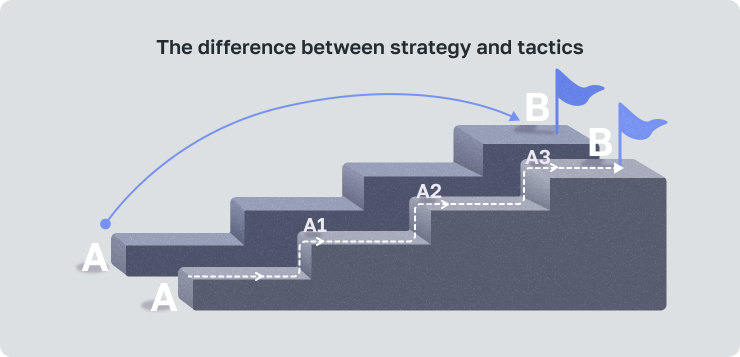
Understanding the difference between strategy and tactics is critical to business success. Strategy provides the overall direction, while tactics are the specific steps needed to achieve goals. While strategy is the action plan that takes you where you want to go, the tactics are the individual steps and actions that will get you there. You can think of the difference between the strategy and tactics as the strategy being the «what» and tactics being the «how».
We all know the phrases “tactical planning”, “business strategy”, don’t we? It’s time to delve deeper into these concepts and find out the goals, objectives, capabilities, features, and difference between strategy and tactics.
Definition of strategy
A business strategy is a high-level, long-term plan aimed at achieving specific company goals. Strategy determines the company’s development course, its market positioning and competitive advantage.
A business strategy helps a company focus resources on achieving goals, make informed decisions, and ensure long-term success.
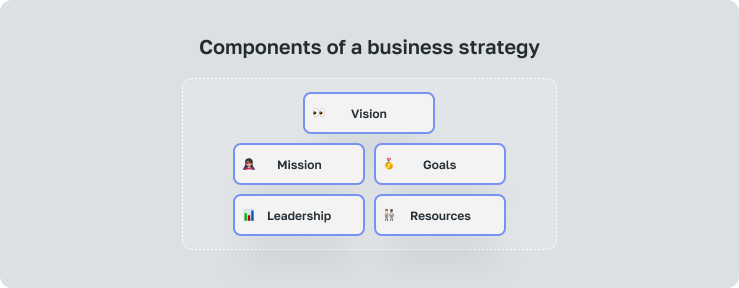
This requires the following basic components of a business strategy:
- Vision: a description of the company’s desired future.
- Mission: defining the purpose and values of the company.
- Goals: specific, measurable, achievable, relevant and time-bound goals that the company strives for.
- Resources: allocation of human, financial and other resources to implement the strategy.
- Leadership: provide leadership and coordination to implement strategy.
Thereby, strategy is a vital tool for any company that wants to achieve long-term success. And that’s why developing a business strategy is an ongoing process that must be reviewed and updated regularly.
Definition of tactics
Tactics in business are a set of specific actions and methods used to implement a business strategy. Tactics focus on short-term goals and details, helping the company bring its long-term vision to life.
Business tactics help a company use resources efficiently, achieve its goals on time, and increase competitiveness.
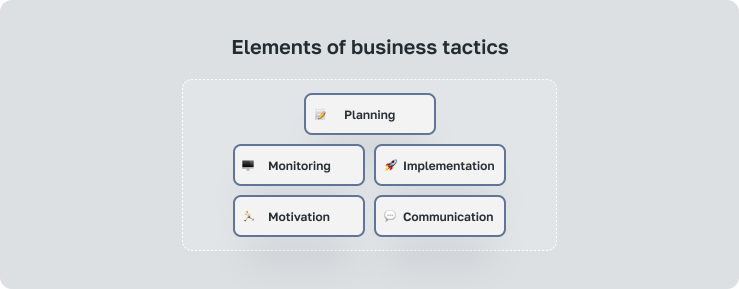
Basic elements of business tactics:
- Planning: developing the specific steps needed to achieve goals.
- Implementation: carrying out planned actions.
- Monitoring: monitoring progress and making adjustments as needed.
- Motivation: encouraging employees to work towards achieving goals.
- Communication: ensuring effective exchange of information between employees.
If you were to compare strategy and tactics in an organization, more often you’ll find that an organization uses any number of tactics but lacks an overall strategy. This is a reminder of how important it is to regularly review and adjust both strategy and tactics.
What makes a good strategy?
All effective strategies have common features. These are the signs by which they can be recognized, and these are also tips on how to build an effective and promising strategy for your company.

The characteristics of effective strategies are:
- Compatibility with institutional aims.
- Adaptability.
- Clarity and understandability.
- Resource support.
Each of these characteristics is critical to a truly strong strategy. To achieve success, a company must pay sufficient attention to each of these parameters. Let’s look at them in detail.
1. Compatibility with institutional aims
Strategy must be directly related to the company’s mission, vision, and goals. It should be designed to maximize their achievement.
Compatibility with institutional aims:
- Increases employee motivation.
- Improves resource efficiency.
- Increases the likelihood of achieving goals.
- Reduces silos between departments.
- Reduces ineffective expenses.
- Reduces the risk of failure.
2. Adaptability
The strategy must be flexible enough to change depending on changes in the external environment (for example, the emergence of new technologies, changes in the competitive environment or economic crises).
The impact of adaptability on business strategy:
- Increases resistance to change.
- Builds the ability to respond to new opportunities.
- Increases competitiveness.
- Reduces the risk of strategy becoming obsolete.
- Reduces losses from failure to adapt.
- Minimizes the likelihood of failure.
3. Clarity and understandability
Strong strategy must be formulated clearly and concisely so that everyone in the organization understands it. This ensures that everyone is working towards the same goals.
How clarity and understandability impact strategy:
- Increase employee engagement.
- Improves consistency of actions.
- Increases implementation efficiency.
- Reduce misunderstandings within the team.
- Protects against inconsistency of actions.
- Reduces the risk of errors.
4. Resource support
A strong strategy requires sufficient resources such as finance, personnel, technology, and information.
In turn, resourcing:
- Increases the likelihood of success.
- Strengthens the effectiveness of strategy implementation.
- Increases employee motivation.
- Reduces the risk of failure.
- Protects against distrust of management.
- Minimizes employee demotivation.
What makes good tactics?
As we’ve learned, tactics are short-term steps that will help you achieve smaller goals along the way to executing your strategy. Tactical planning is the breaking down of a strategic plan into short-term actions. These actions are successful if they have the following attributes:
- Consistency with the overall strategy
- Flexibility
- Controllability
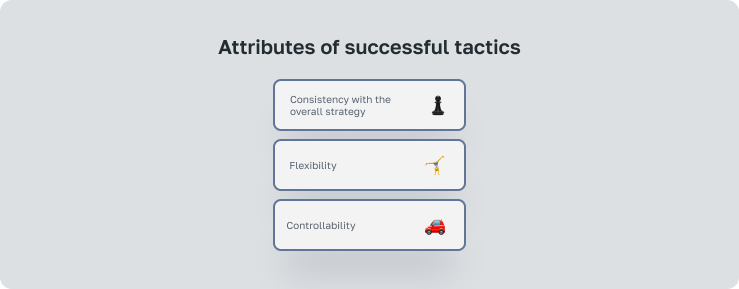
In addition to these aspects, successful tactics should also be realistic, innovative and clearly communicated to all employees. We will take a closer look at the key features of good tactics that significantly increase the chances of successful implementation and achieving the desired results.
1. Consistency with the overall strategy
Tactics should be directly related to and flow from the overall company strategy. It should be aimed at achieving the goals set within the strategy.
If your tactics are harmonized with your strategy, then it:
- Increases the efficiency of resource use.
- Increases the likelihood of achieving goals.
- Improves employee motivation.
- Reduces silos between departments.
- Eliminates ineffective expenses.
- Minimizes the risk of failure.
2. Flexibility
Tactics must be flexible enough to change depending on changes in the external environment, such as the emergence of new technologies, changes in the competitive environment or economic crises.
A fairly flexible tactic has the following capabilities:
- Increases resistance to change.
- Builds the ability to respond to new opportunities.
- Strengthens competitiveness.
- Reduces the risk of tactics becoming obsolete.
- Reduces losses from failure to adapt.
- Minimizes the likelihood of failure.
3. Controllability
Tactics must be measurable and controllable. This allows for regular monitoring of progress and making necessary adjustments.
Controlled tactics provide the following advantages:
- Increases efficiency.
- Expands adaptability.
- Strengthens the team’s confidence in the correctness of the company’s course.
- Reduces the risk of deviation from the strategic course.
- Eliminates ineffective expenses.
- Reduces the likelihood of errors.
Developing and implementing successful tactics is a complex and time-consuming process that requires careful planning, execution, and monitoring.
Examples of business strategy and tactics
Competent strategy and tactics development provides invaluable support to a business. This planning takes a lot of time and resources, but it is worth it.
You’ll see the importance and power of good strategy and tactics through three real-life examples of strategy and tactics in a business context:
Example 1: Apple’s Strategy 
Strategy: Become the market leader in consumer electronics.
Tactics
- Development of innovative products (iPhone, iPad, and Apple Watch) focused on design and ease of use.
- Marketing: premium positioning. Creation of the «Apple cult».
- Sales: control over sales channels. Creation of an Apple Store network.
- Result: Apple has become one of the most valuable companies in the world.
Example 2: Starbucks’ strategy for entering
a new market 
Strategy: Dominate the coffee market in a new country.
Tactics
- Adapting the menu to the tastes and preferences of local residents. Creating café interiors in accordance with local culture.
- Pricing: affordable prices, competitive with local coffee shops.
- Marketing: advertising campaigns aimed at local audiences. Support for social and cultural projects.
- Result: Starbucks became the coffee market leader in the new country.
Example 3: Improving Nike’s Competitiveness 
Strategy: Become a market leader in sportswear and footwear.
Tactics
- Development of new technologies such as Air Max and Flyknit. Cooperation with famous athletes.
- Marketing: global advertising campaigns targeting different target audiences. Sponsoring sporting events.
- Range expansion: entering new markets such as fitness and everyday street style.
- Result: Nike became the market leader in sportswear and footwear.
Manage strategy and tactics using work management tools
Strategy and tactics complement each other. A successful strategy without effective tactics is useless. At the same time, effective tactics without strategy can lead to chaos.
Managing strategy and tactics simultaneously, optimizing and executing them can be challenging. Using company management tools can make this task easier. Company performance management tools can be invaluable in helping you track and optimize strategy and tactics.

One of the clearest examples is Worksection project management service that allows to plan dofferent-term and track tasks, find bottlenecks, complete projects in time and make a workflow absolutely transparent.
Tracking task completion

- Tools allow you to set SMART goals, cascade them from strategic to tactical tasks, link tasks with KPIs and track progress in their implementation.
- A visual system of schedules, Kanban boards and timers helps not to miss deadlines and synchronize the work of different teams.
- Task progress reports allow you to identify bottlenecks and make course corrections.
Optimization of business processes

- Automating routine tasks frees up time for more important things.
- Built-in chats, forums, and notification systems enhance communication and collaboration between employees.
- Project management to plan, control and analyze projects to achieve better results.
Tracking strategic goals
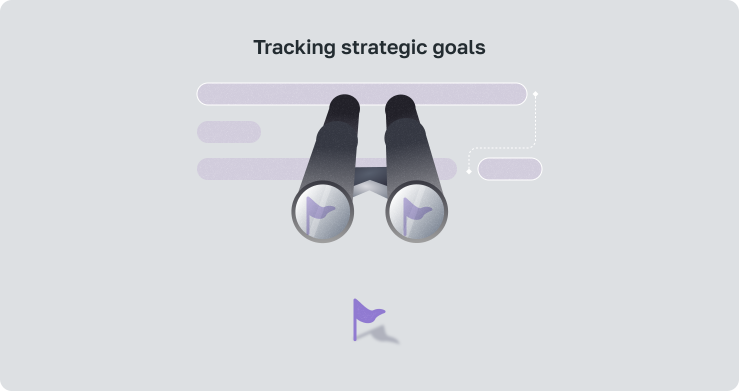
- Setting long-term goals and cascading them into specific tasks for each employee.
- Planning and monitoring marketing activities, monitoring their effectiveness and adjusting strategy.
- Setting tasks for teams, monitoring deadlines and quality of work, tracking project progress.
In this way, work management tools can significantly improve the efficiency of implementing business strategies and tactics. They help track progress, streamline processes, and increase transparency and accountability.
It is essential to choose a tool that suits the needs and size of your company. In this case, it is important to take into account such factors as: functionality, ease of use, reliability of the team work management system.
How to build an organizational strategy
Together we found out what is a tactics and what a strategy is. Are you ready to create a strategy for your business? In this case, you will find our guide to developing a comprehensive business strategy useful.
Define your goals
- Describe the vision: Where do you want your company to be in the future?
- State your mission: What is your company’s goal?
- Define strategic goals: What do you want to achieve in the long term?
Analysis
- Conduct a SWOT analysis: Assess the company’s strengths and weaknesses, as well as the opportunities and threats in the market.
- Research competitors: Study their strategies, strengths, and weaknesses.
- Analyze the market: Assess market size, trends, pricing and competitive landscape.
- Choose a strategic focus: What will you focus on?
- Develop a Competitive Advantage: How will you differentiate yourself from your competitors?
- Identify key success factors: What factors will determine your success?
- Break down goals into tasks: Turn strategic goals into specific tasks.
- Allocate Resources: Determine what resources you will need to implement the strategy.
- Set deadlines: Set deadlines for completing tasks.
Monitoring and evaluation
- Track the progress: Monitor task completion regularly.
- Evaluate effectiveness: Compare results with plans and adjust strategy if necessary.
- Conduct an audit: Regularly evaluate the effectiveness of the strategy and make necessary changes.
Examples of strategies for different company types:
- Differentiation Strategy: Offer unique products or services that differentiate you from your competitors.
- Cost leadership strategy: Reduce costs to become a cost leader.
- Focus Strategy: Concentrate on a specific market segment or product.
For the best results, involve all stakeholders in strategy development: employees, clients, investors.
Provide transparency and communicate the strategy to everyone in the company. And be prepared for change: adjust your strategy according to changes in the market.
Developing a comprehensive business strategy and tactics is a complex and time-consuming process, but it is essential to achieve long-term success. Use this guide as a starting point and adapt it to your company’s needs.
